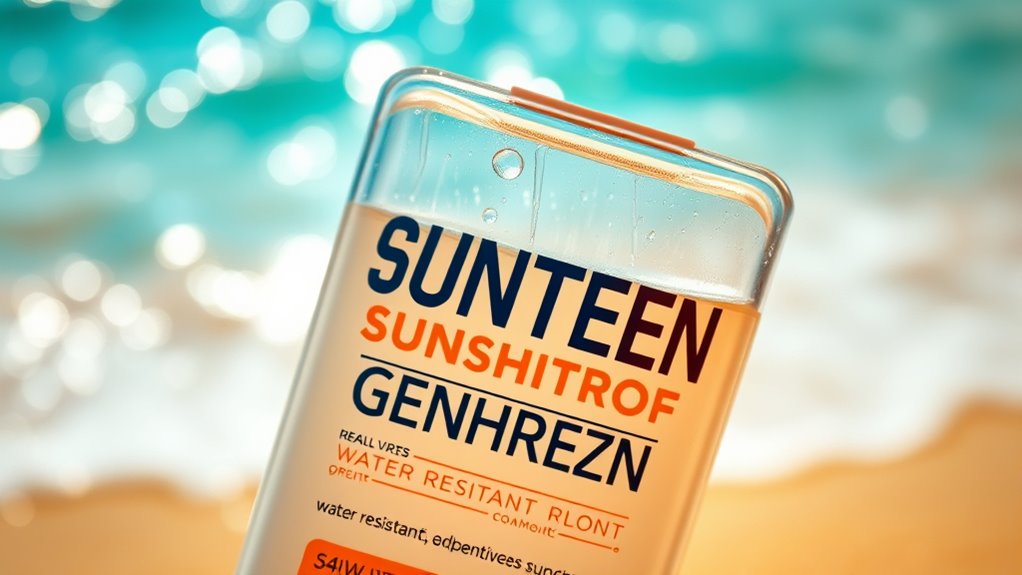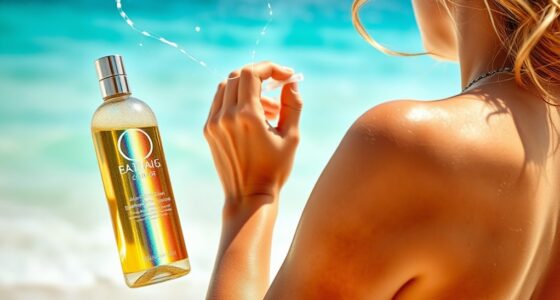Water-resistant sunscreens aren’t just marketing hype; they’re formulated to maintain their UV protection during water exposure and sweating, based on standardized testing. However, they are not waterproof, and protection diminishes after the specified time—usually 40 or 80 minutes. Proper reapplication is essential, especially after swimming or heavy sweating. To truly understand what makes water-resistant sunscreens effective and how to use them best, explore the facts behind their design and claims.
Key Takeaways
- Water-resistant sunscreens are tested to maintain SPF for 40 or 80 minutes during water exposure, not fully waterproof.
- Claims are regulated by agencies like the FDA, based on standardized controlled water immersion tests.
- Reapplication every 40-80 minutes is essential, as water resistance does not prevent sunscreen from washing off.
- Formulation techniques include film-forming polymers and water-in-oil emulsions to enhance water resistance.
- Water resistance is a marketing term based on testing standards; actual protection varies with environmental factors and physical activity.
What Does “Water-Resistant” Really Mean?
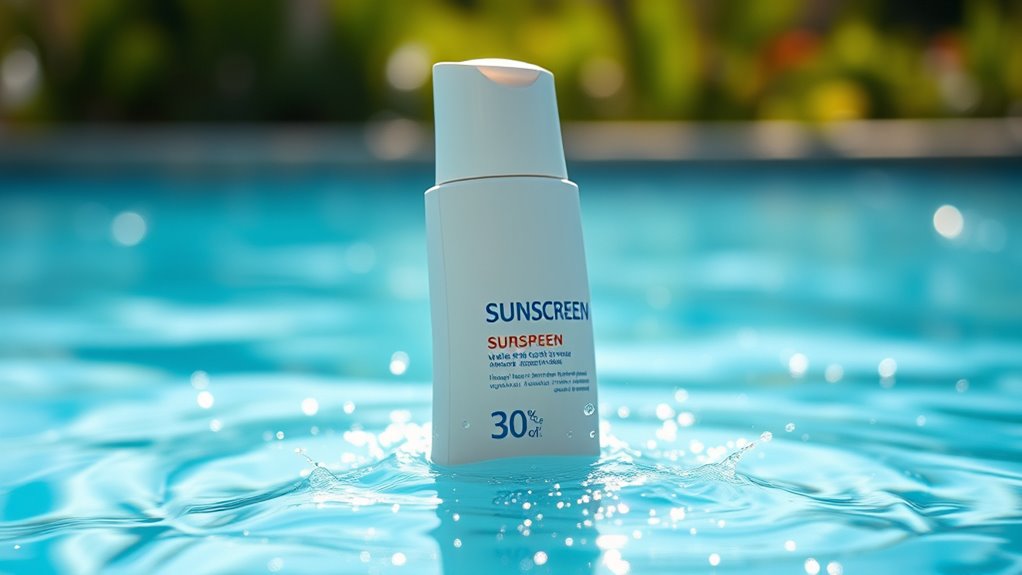
Understanding what “water-resistant” really means is essential for using sunscreen effectively. According to the FDA, water-resistant sunscreens are tested to stay effective for either 40 or 80 minutes while you’re in water. This means the SPF remains stable during that time, but it doesn’t last forever. Labels must specify how long the protection endures, so you know when to reapply. Remember, there’s no such thing as waterproof sunscreen—despite what some labels might suggest in the past—because all sunscreens eventually wash off. The testing involves controlled water exposure to verify SPF retention. Knowing this helps you plan reapplications after swimming or sweating, ensuring continuous protection. Proper reapplication is key to maintaining effective sun protection during water activities. Additionally, understanding sunscreen efficacy helps you select the right product for your needs. Always follow label instructions to maximize your sun safety, especially when water or sweat is involved. Regularly checking and reapplying sunscreen as recommended can prevent UV damage and reduce the risk of sunburn. Proper application techniques and water resistance also play a crucial role in ensuring your skin remains protected during outdoor activities. Being aware of cybersecurity vulnerabilities, such as during outages or attacks, highlights the importance of reliable product information and secure online purchasing for your sun protection needs.
How Do Sunscreen Formulations Resist Water and Sweat?
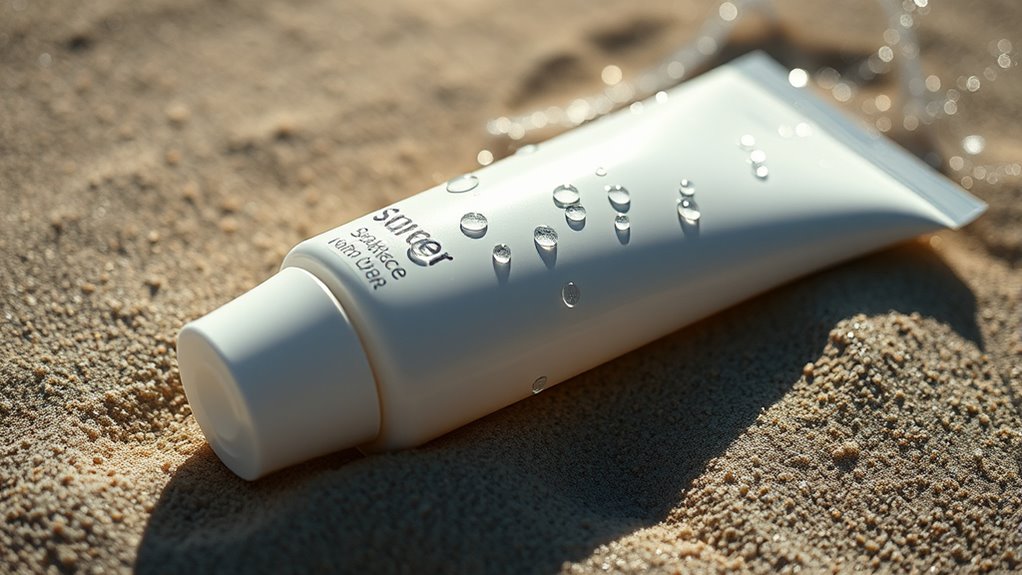
Sunscreen formulations are designed to stay put even when you’re swimming or sweating. They use film-forming polymers that create a water-insoluble layer on your skin, helping the sunscreen resist wash-off. These polymers, like acrylates and silicone-based types, dissolve in alcohol during application and then harden into a flexible, durable film. Water-resistant sunscreens often use water-in-oil emulsions, which trap water droplets inside an oil phase, creating a barrier that prevents water from removing the product. Hydrophobic ingredients, such as coated zinc oxide or silicone polymers, enhance water repellency and help maintain UV filter placement. Additionally, encapsulation techniques, like liposomes, trap UV filters, further preventing wash-off. Advanced formulation techniques contribute to the overall effectiveness and longevity of water-resistant sunscreens. Together, these features ensure your sunscreen stays effective even during water activities or heavy sweating. The use of water-resistant formulas is especially important for those engaging in outdoor sports or swimming. Advances in film-forming technology have contributed significantly to the effectiveness of water-resistant sunscreens, making them more reliable than ever. Moreover, the incorporation of long-lasting polymers helps improve the durability of the protective barrier under various conditions. Incorporating waterproofing agents further enhances the ability of sunscreens to resist water and perspiration, ensuring prolonged protection.
Efficacy Duration: What Happens Over Time?
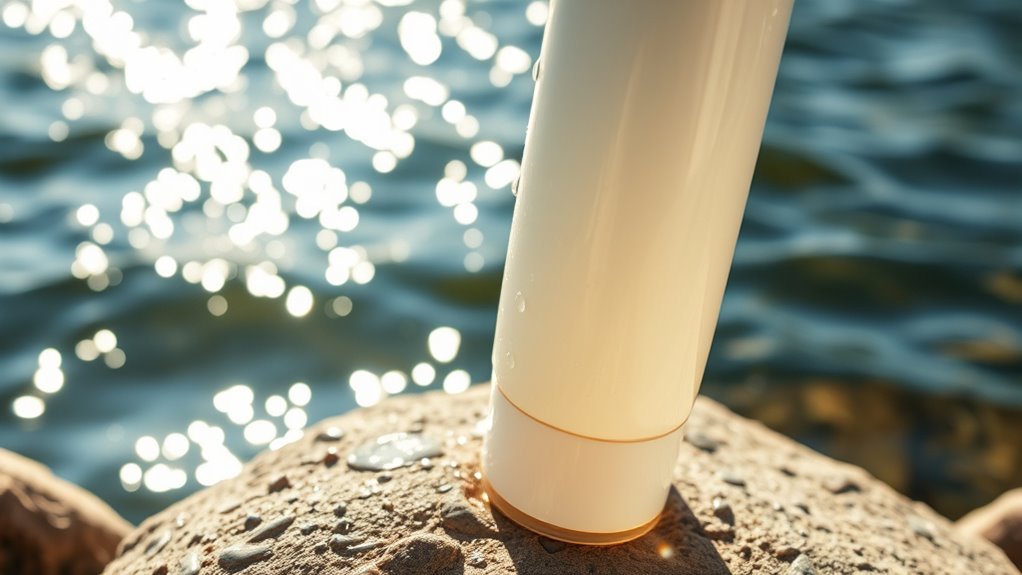
The effectiveness of water-resistant sunscreens diminishes over time, especially after exposure to water, sweat, or extended sunlight. While SPF ratings specify how long a sunscreen remains effective under ideal conditions, actual protection decreases as time passes. Water resistance ratings of 40 or 80 minutes indicate how long the product can stay effective during water exposure, but sweating and towel drying can reduce this duration. After about two hours, protection levels drop, even if you haven’t been swimming. Environmental factors like heat and humidity also accelerate wear. Reapplication every two hours is essential, particularly after activities like swimming or sweating. Proper reapplication techniques ensure continuous protection and help maintain the effectiveness of water-resistant sunscreens. Remember, higher SPF doesn’t extend protection time—regular reapplication is key to maintaining effective UV defense. Additionally, understanding Gold IRA fees can help investors maximize their returns when considering diversification, just as reapplying sunscreen helps maintain protection. To maximize effectiveness, product formulation and adherence to reapplication guidelines are crucial for consistent UV protection, especially since UV exposure can degrade the active ingredients over time. Continuous education about sunscreen properties, such as water resistance, can aid in choosing the best products for various outdoor activities.
The Importance of Reapplication During Water Activities
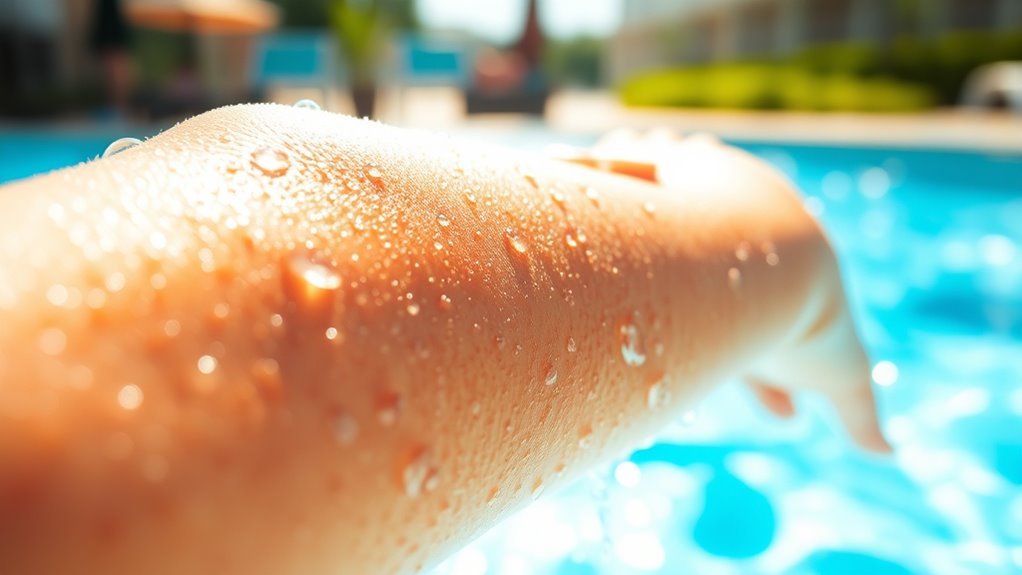
When you’re participating in water activities, reapplying sunscreen is vital to maintaining your skin’s protection. Water-resistant formulas protect for about 40 minutes, while waterproof options last up to 80 minutes. However, water, sweat, and towel drying remove or dilute sunscreen, so a single application isn’t enough. Reapply immediately after swimming, sweating heavily, or towel drying to guarantee continuous coverage. Remember, high SPF ratings don’t extend protection time or eliminate the need for reapplication. The label’s water resistance duration is only valid during wet conditions; once the skin is wet or dry, reapplication becomes necessary. Using UV protection technology in sunscreens can enhance effectiveness during water activities. Additionally, understanding payment processing can improve the way you manage transactions related to water sports rentals or merchandise. Staying vigilant helps prevent sunburn, UV damage, and long-term skin issues. Proper sunscreen application and reapplication practices are essential for effective sun protection during water activities. Incorporating generative AI tools can assist in customizing sun protection advice based on individual activity levels and environmental factors. Regularly checking the water resistance label can help ensure you reapply at appropriate intervals for maximum protection.
Safety Benefits of Water-Resistant Formulas
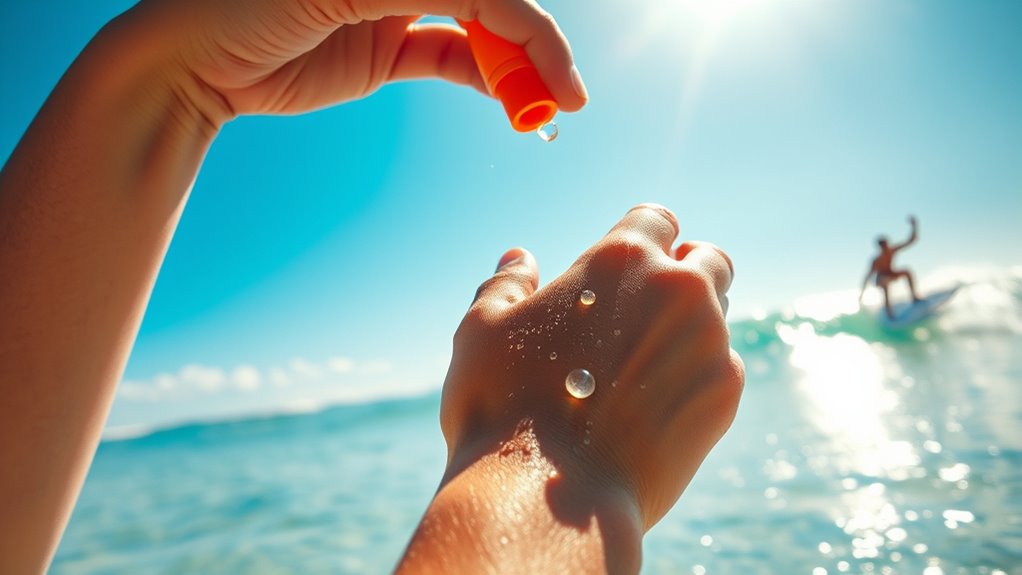
Water-resistant formulas provide a crucial safety benefit by maintaining UV protection even when you’re immersed in water or sweating. They create a durable barrier on your skin that continues to block harmful UVA and UVB rays during swimming or intense activity, reducing the risk of sunburn and long-term skin damage. These formulas also protect against chlorine and other irritants, minimizing skin sensitivity and dryness caused by pool chemicals. Their enhanced durability ensures SPF levels stay effective during water and sweat exposure, so you don’t need to reapply immediately after brief contact. Additionally, many include moisturizing ingredients that help preserve your skin’s hydration and barrier. Proper formulation stability is essential to ensure that water-resistant sunscreens reliably maintain their efficacy over time. This stability depends on the ingredients used and how the formulation is processed. Incorporating water-resistant ingredients enhances the product’s ability to withstand exposure to water and sweat, further improving its protective qualities. The testing standards established by regulatory agencies help verify the claims of water resistance, giving consumers confidence in their product choices. Overall, water-resistant sunscreens support consistent sun protection, promoting safer outdoor and aquatic activities without compromising skin health.
Limitations of Water Resistance and Common Misconceptions
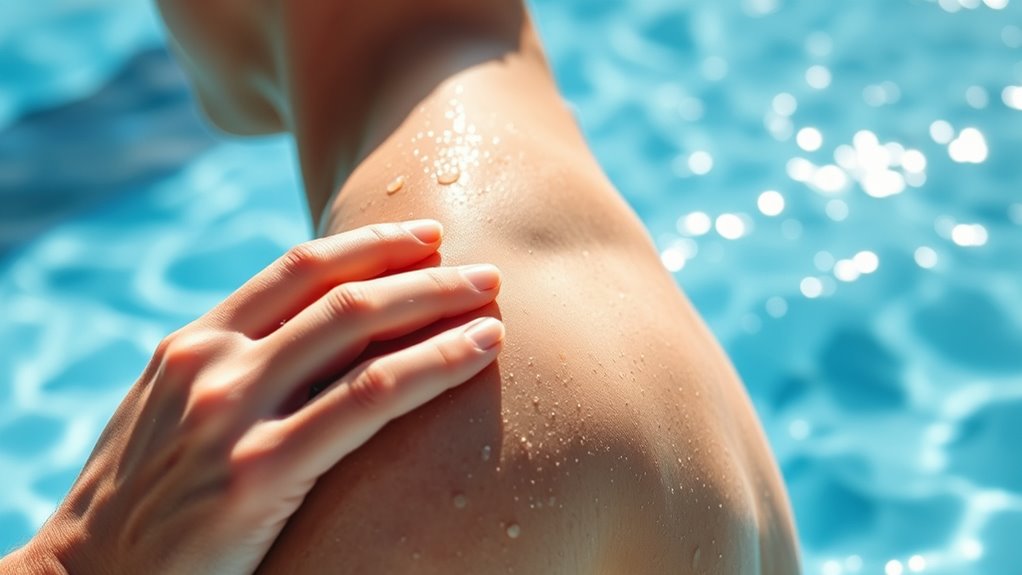
While water-resistant sunscreens are designed to keep you protected during water activities, their effectiveness isn’t unlimited. The FDA restricts labels to specify either 40 or 80 minutes of water resistance; beyond that, reapplication is necessary. Many people mistakenly believe water resistance means all-day protection, which isn’t true. Water resistance relies on film-forming ingredients that delay water from washing away sunscreen, but factors like sweating, towel drying, and skin oils can reduce effectiveness. Heavy water exposure or activity doesn’t guarantee full protection. Additionally, environmental factors such as salt or chlorine can weaken the barrier. Remember, reapplying every 40 or 80 minutes, or more often if needed, is essential to maintain protection. Misunderstanding these limits can lead to sunburn and increased UV damage.
Marketing Claims vs. Scientific Standards
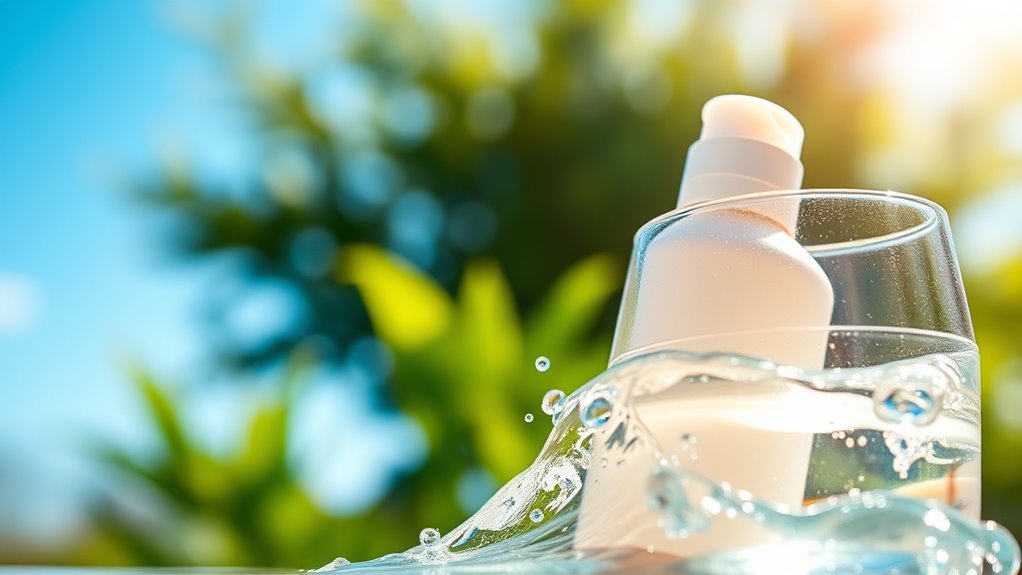
Marketing claims about sunscreen’s water resistance often oversimplify or exaggerate their true capabilities, creating confusion among consumers. Many sunscreens are labeled as water-resistant rather than waterproof, meaning they can maintain SPF after water exposure for 40 or 80 minutes. These claims are regulated by agencies like the FDA, which require specific testing and labeling standards. Scientific testing involves immersing products in water under controlled conditions and measuring SPF retention, following ISO or national standards. Formulators face challenges balancing water resistance with skin feel and performance, leading to variability in effectiveness. As a consumer, it’s essential to understand that these claims are based on standardized tests, not real-life situations. Always read labels carefully and remember that reapplication is necessary after water exposure.
Tips for Maximizing Protection With Water-Resistant Sunscreens
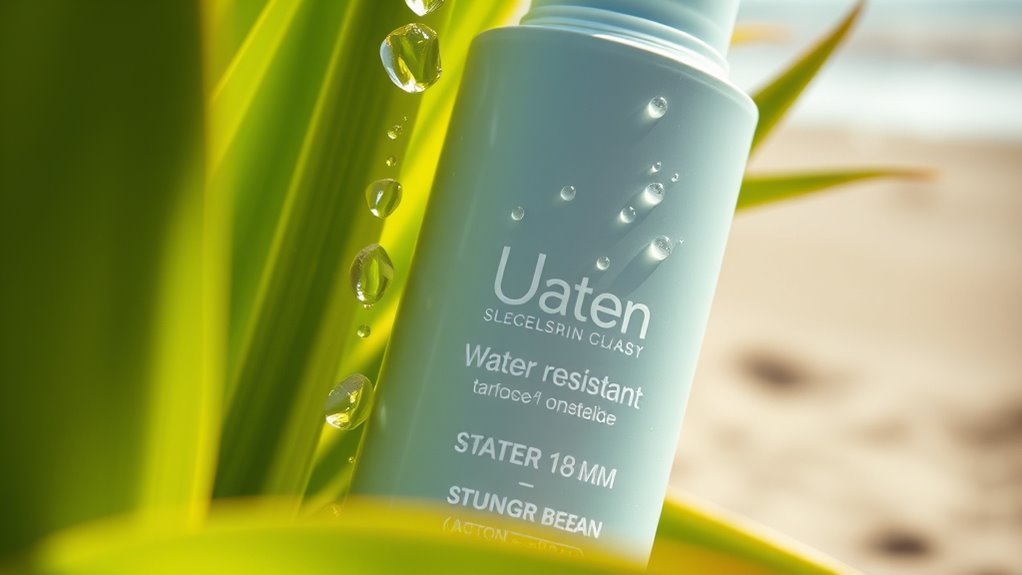
To maximize the effectiveness of your water-resistant sunscreen, it’s crucial to apply it correctly and at the right time. Apply at least 15–20 minutes before water or activity to let it set properly. Make sure your skin is dry, then use about a golf ball-sized amount to cover all exposed areas evenly, avoiding missed spots. Reapply every 40 to 80 minutes during swimming or sweating, and immediately after towel drying or heavy sweating. Remember, water-resistant doesn’t mean waterproof—reapplication is essential. Use formulas designed for your activity level and consider adding physical barriers like hats or UV-protective clothing. Combining these tips ensures you stay protected, even during prolonged water exposure or intense activity.
Frequently Asked Questions
Can Water-Resistant Sunscreen Be Considered Fully Waterproof?
You might wonder if water-resistant sunscreen is fully waterproof, but the answer is no. Water-resistant formulas are designed to maintain protection for a specific time during water activities, usually 40 or 80 minutes, but they aren’t completely waterproof. They can wash off or degrade with prolonged exposure or friction. To stay protected, you should reapply regularly and don’t rely solely on the label’s claims of water resistance.
Does Sweating Impact the Effectiveness of Water-Resistant Sunscreens?
Imagine you’re outdoors, sweating during a workout—it turns out, sweat can impact your sunscreen’s effectiveness. While water-resistant formulas are designed to stay put during water or sweat, they aren’t sweat-proof. Sweat can wash away or unevenly distribute sunscreen, reducing protection. To stay safe, reapply every 40-80 minutes, especially during intense activity, and choose formulas tailored for high-exertion scenarios, because even water-resistant sunscreens aren’t completely immune to sweat.
How Often Should I Reapply Water-Resistant Sunscreen During Outdoor Activities?
You should reapply water-resistant sunscreen every 80 minutes during outdoor activities involving swimming or sweating. If you’re not in the water or sweating heavily, stick to reapplying every two hours. Always reapply immediately after towel drying or vigorous water contact to maintain protection. Keep in mind, water resistance helps the sunscreen stay effective longer during water activities, but regular reapplication is essential to prevent sun damage.
Do All Water-Resistant Sunscreens Provide the Same Duration of Protection?
Not all water-resistant sunscreens offer the same duration of protection. Some provide 40 minutes, while others last up to 80 minutes, depending on their formulation. You should always check the label for the specific time listed, and reapply accordingly to maintain protection. Keep in mind that activity level, sweating, and water exposure can affect how well the sunscreen works, so playing it safe is key.
Are There Differences in Water Resistance Between SPF Formulations?
You might wonder if SPF formulations affect water resistance. While higher SPF sunscreens offer more UV protection, they don’t necessarily last longer in water. Water resistance depends on formulation techniques like film-forming polymers and carriers, not SPF level. Thus, a broad-spectrum SPF 30 can be just as water-resistant as SPF 50+ if formulated properly. Always check the label for water resistance duration and reapply as recommended after water exposure.
Conclusion
Remember, water-resistant sunscreen is your fiercest shield against the sun’s relentless assault—like armor that fights off sweat and splashes! But don’t get complacent; it’s not invincible. Reapply generously and often, especially during water adventures. Think of it as your ultimate sun-saving sidekick—powerful, but not superhuman. Trust in science, follow the tips, and keep your skin safe from the blazing, unyielding sun. Stay protected, stay unstoppable!
